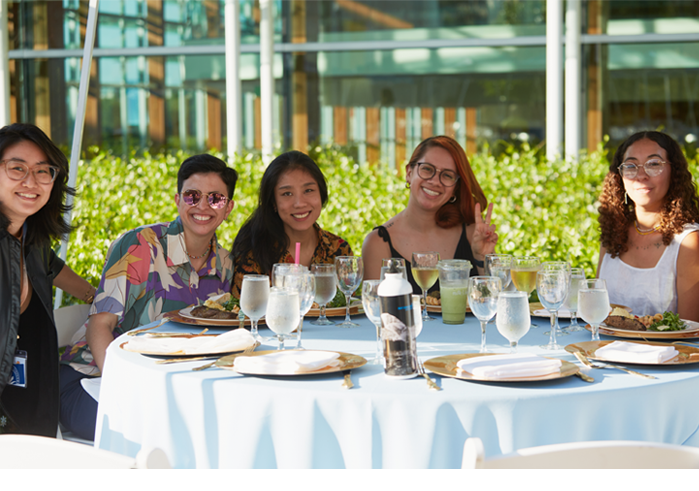A Successful and Spirited Reunion for the Class of 2013

When he joined a group of alumni planning the 10th reunion of the class of 2013, Eddie Ng wondered if the bonds that his classmates had created on campus remained and how many would even attend the event.
Ng was happily surprised. Sixty-seven members of the class and 42 guests returned to Aliso Viejo for the reunion July 29 and 30, a decidedly strong showing that included alumni who flew in from around the world.
“It felt almost surreal how people who hadn’t spoken in years just seemed to pick up where they left off,” Ng said. “We realized that even though we may not have been such a tight class during our four years at Soka, it was a community that we also haven’t been able to recreate with any other community since graduating.”
Over the weekend-long event, attendees heard from fellow alumni including Ben Walder, Seonmi Jin, Cole Gauthier, and Yoko Tomita, as well as from Profs. Michael Golden, Phat Vu, and Seiji Takaku. They enjoyed lunch with members of the local SUA community and students; performances and dance parties at the Black Box Theatre; a closing ceremony that included remarks from SUA President Ed Feasel; and plenty of free time to relax and reconnect.
A Dedicated Planning Committee
Jolie Tea-Taniguchi ’11 admitted she also wasn’t expecting such a great turnout. Tea-Taniguchi, who’d been involved in Sohokai activities since graduating and is currently serving her second year on its board, had noticed the class of ’13 previously didn’t have much involvement with alumni events. Although the alumni board doesn’t usually assist with reunion planning, Tea-Taniguchi and her peers stepped in during a transition period in SUA’s alumni relations office, helping to coordinate contact between the Reunion Core Committee and the university as the weekend grew closer.
Tea-Taniguchi credits that core committee—Kiyoshi “Red” Akasu, Naoka Tanaka, and Aiki Segawa Matsukura—with generating excitement about the weekend. The committee members were “always thinking about the best way to support and encourage their classmates,” said Tea-Taniguchi. About 30 other members of the class signed on to help, forming six subcommittees with specific tasks. Members of the outreach subcommittee, for example, focused on following up with each classmate to answer any questions and encourage people to attend.
“I heard some instances from individuals who had not been too connected to SUA upon graduating, but they were directly contacted by a classmate about the reunion,” Tea-Taniguchi said.
Ng, who assisted with communications, said as more and more people decided to attend the reunion, the planners’ enthusiasm grew. But they also heard from those who were hesitant to attend because they felt they hadn’t accomplished enough in their lives. To acknowledge those doubts and assure everyone that their presence and not their achievements mattered to their peers, the committee chose its reunion theme: Just B.
In their remarks during the opening session, Tanaka explained the theme and shared the idea that the feeling of not being ready to attend a reunion stemmed in part from how much SUA students care about making a difference in the world.
“I believe this is a unique struggle we have as SUA students and sometimes it honestly feels like we need to be heroes of the world to be able to come back to SUA as proud graduates,” Tanaka said. “And this expectation we have or we face from others can be very real sometimes.
“Whether it be social norms of what parenthood should look like or expectation from family members or even ourselves on who we should become, it often becomes easy to overlook the significance of recognizing where we are now in our respective journeys, especially if we are struggling. But just being ourselves is so worthy and showing up each day is, in fact, one of the most significant impacts we make each day.”
Ng said any lingering self-doubt quickly disappeared once the former students reconnected. “It was very clear from the first night that none of that really mattered at all,” he said.
Sharing Stories and Talents
The planning committee tried to strike a balance between activities for alumni and their families, and time for people to relax and reconnect. Ng said feedback from previous reunions suggested that alumni didn’t want to be overscheduled, and “just really wanted to be in the same space together.”
Still, there were plenty of activities throughout the weekend. One of Ng’s favorites was the talent show, inspired when the planning committee recalled that as students they often celebrated birthdays with ad hoc parties and performances. Another was hearing during an open mic session from some classmates who were not able to graduate with most of the class. “It was moving to hear their stories of how that impacted them but that they still feel a part of 2013,” Ng said. “No matter what, we are forever connected.”
Tea-Taniguchi didn’t have a campus 10-year reunion due to the pandemic, and being part of the class of 2013’s helped her understand the value and importance of in-person gatherings, and also gave her ideas to build on for future reunions.
“Everyone seemed so genuinely happy to see each other,” she said. “Even people who might not have interacted much while they were students, or spouses and family members, felt the warmth and joy of being part of the SUA community. For those that had not returned back to SUA in a long time, they were very happy and excited to see the campus enhancements that were made throughout the years. I really felt that everyone walked away with a deeper sense of appreciation and gratitude for SUA and each other.”
